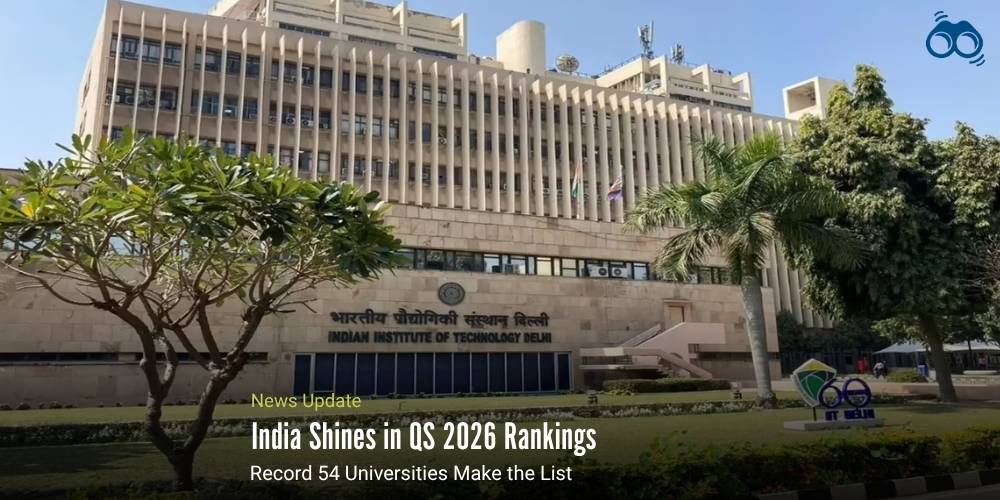India Adds Most New Universities to QS 2026 Rankings, Surpasses 50 Mark
IIT Delhi Leads as India Records Highest-Ever Presence in QS Rankings
India has made significant strides in the QS World University Rankings 2026, with a record 54 universities featured, its highest representation to date. The country now ranks fourth globally for the number of institutions included, behind only the United States (192), the United Kingdom (90), and Mainland China (72). This marks a dramatic rise from just 11 ranked universities a decade ago, reflecting a 390% increase, the strongest growth among G20 nations.
According to QS, India added eight new universities to the rankings this year, more than any other country. Jordan and Azerbaijan followed with six new entries each. QS officials noted that nearly half of the 46 Indian institutions ranked in 2025 improved their positions in 2026, signalling a broad-based upward trend. The Indian Institute of Technology (IIT) Delhi emerged as the highest-ranked Indian institution, climbing to 123rd place, up from 150 last year and 197 the year before. Its rise has been credited to strong performances in Employer Reputation (ranked 50th), Citations per Faculty (86th), Sustainability (172nd), and Academic Reputation (142nd). IIT Delhi now shares its rank with the Georgia Institute of Technology in the United States.
In comparison, IIT Bombay saw a slight decline, dropping from its all-time best rank of 118 in 2025 to 129th in 2026. Despite the dip, it continues to feature in the global top 130 and excels in Employer Reputation, where it is ranked 39th globally. Among India’s 11 Institutes of Eminence, comprising both public and private institutions, six improved their rankings. Notably, IIT Madras made a breakthrough by entering the top 200 for the first time, climbing 47 places to reach 180th. All three private Institutes of Eminence also advanced, with Shoolini University of Biotechnology and Management Sciences (503rd) and Chandigarh University (575th) ranked higher than Birla Institute of Technology and Science (668th) among private universities.
Jessica Turner, CEO of QS, remarked that India is rapidly reshaping the global higher education landscape. She stated that no other country had introduced more new institutions to the rankings this year, highlighting the speed and scale of India’s transformation. Turner also emphasised that in a country where over 40% of the population is under 25, expanding access and improving quality in education is not merely a policy choice but a national priority. She cited QS estimates suggesting that India would need to build the equivalent of 14 new universities every week to achieve its target of a 50% Gross Enrolment Ratio by 2035.
Turner acknowledged that Indian universities are making notable progress in areas such as Citations per Faculty, Sustainability, and building International Research Networks. However, she pointed out that challenges remain, particularly in attracting international students and faculty, and in ensuring academic capacity keeps pace with rapid growth. Ashwin Fernandes, QS Regional Director for the Middle East, Africa, and South Asia, echoed these views, noting that India’s rising performance in global rankings reflects not only the growing strength of its leading institutions but also the expanding ambition of its higher education ecosystem. He highlighted India’s increasing global engagement, rising research investment, and sharper focus on employability as key drivers of this transformation.
Editor’s Note:
India’s remarkable rise in the QS World University Rankings 2026 is more than a symbolic achievement; it marks a decisive shift in the global higher education landscape. With 54 institutions featured, including eight new entrants, India has demonstrated that it is not only expanding its academic footprint but also competing with the world’s most established systems on quality and ambition. What stands out is not just the upward mobility of elite institutions like IIT Delhi and IIT Madras, but the steady progress across a broader spectrum of universities. This indicates that the country’s higher education strategy, centred on research, employability, and global engagement, is beginning to deliver results. The Institutes of Eminence framework, for instance, appears to be creating tangible outcomes, both for public and private institutions.
According to Skoobuzz, the true challenge lies in scaling quality while maintaining global competitiveness. To meet its Gross Enrolment Ratio targets and secure a lasting place in the top tier of international academia, India must invest more in faculty development, internationalisation, and infrastructure.














0 Comments (Please Login To Continue)